ABSTRACT
BACKGROUND
Neck pain is recognized as the fourth leading cause of disability worldwide. The severity of neck pain may lead to adverse outcomes related to individual’s health and well-being that augment the risk of disability and may severely interfere in activities of daily living (ADL’s) and participation in the society.
AIM
The aim of the quantitative analysis is to determine the effectiveness of yoga in relieving chronic neck pain and disability.
METHODS
Databases such as Google scholar, MEDLINE, PEDro, the Cochrane Library and Pub Med were explored from October-November for randomized controlled trials which assessed neck pain and related disability among chronic neck pain individuals.
RESULTS
Total six studies consisted of 298 participants with chronic neck pain. In risk of bias assessment, all six studies reported low risk of allocation and reporting bias, while one or two study disclosed high or unknown risk of bias in several domains. Moderate to large effect of -0.857 SMD at 95% CI suggest evidence in favor of the effectiveness of yoga; (Q 30.32, df 5, I2 83.51%) on a significant P-value of <0.0001.
CONCLUSION
The analysis of studies provided robust evidence with pool effect of -0.857 SMD at 95% CI (p<0.0001) concluded that yoga is an effectual and complementary method for the management of chronic or non-specific neck pain.
KEYWORDS
Yoga, Neck Pain, Cervical, Therapeutic, Prevention, Meditation
Jaza Rizvi
Lecturer
Ziauddin College of Rehabilitation Sciences
Ziauddin University
Batool Hassan
Lecturer
Ziauddin College of Rehabilitation Sciences
Ziauddin University
Sadia Shafaq
Physiotherapist
Metropolis Health
[Rizvi J, Hassan B, Shafaq S. Yoga in Chronic Neck Pain: An Effective Complementary Therapeutic Option. A Meta Analysis.Pak. j. rehabil. 2018;7(2):3-12]
With high prevalence and recurrence rate, the most common musculoskeletal pain disorders are neck and back pain with an annual prevalence of 30%1. Neck pain is recognized as the fourth leading cause of disability worldwide2. Globally, the neck pain is becoming common and has a significant effect on individuals, their families, health-care systems, communities and businesses, ultimately increasing the burden of disease3.In particular, the severity of neck pain may lead to adverse outcomes related to individuals’ health and overall well-being that augment the risk of disability that may severely interfere in activities of daily living (ADL’s) and participation in the society. However, most events of acute neck pain will ultimately resolve with or without the pain management, whereas 50% of individuals may continue to suffer some degree of persistent or frequent pain episodes2. Furthermore, these occurrences may spontaneously resolved over a time period of weeks to months, yet most of the individuals might left with residual or recurrent symptoms of the pain episode. In addition, it has also been observed that the treat-ment approach in acute neck pain appears to have small effect on the course of pain manage-ment2.
Interestingly, distress among individuals with chronic neck pain is interrelated and tends to have fewer
treatment options4. Among the treatment approaches of neck pain, conservative method including care by a general practitioner, manual therapy by a physiotherapist and combination of both are being commonly used5.Contemporary, a review based on the effects of different non-phar-macological interventions established robust evidence that methods such as interdisciplinary approach, cognitive-behavioral therapy, exercise interventions and spinal manipulation are moder-ately effective in chronic pain management. Besides, a fair evidence for acupuncture, massage and yoga was inaugurated6.
A number of studies revealed that millions of Ameri-can adults commonly used Yoga as an adjunct therapy for back and neck pain7. Originated from ancient India, but from last century it is more popu-lar in west. According to the survey conducted by the US National Health Interview Survey (NHIS) from year 2002-2012 concluded that the practices of yoga in the USA have approximately increased from 5.1% to 9.5% specifically in the people aged 18-448. In addition to it, yoga practices that involve meditation, physical postures, lifestyle modification advice and spiritual practices9 are thought to generate the balance among physical, emotional, and spiritual domains with an infinite aim of combin-ing mind, body, and spirit.
Yoga is most commonly related with Pranayama (breathing techniques), Asanas (physical postures), and Dyana (meditation) in North America and Europe9.Currently, for chronic disease conditions meditation has been used as an adjunctive treat-ment. Short-term programs of relaxation and Mind-fulness-Based Stress Reduction (MBSR) and medita-tion have been found as a supportive treatment of chronic pain patients. Mindfulness programs have manifested clinical effects that are beneficial for various health problems, including mood and anxiety disorders, prevention from relapse of depression and quality of life in cancer patients11. In general, people are following yoga to reduce stress and improve general wellness12. However, yoga has shown as an effective treatment for different health conditions including asthma13, depression14, pain and arthritis15.Even though, a recent clinical trial endorsed the efficacy of Yoga for chronic neck pain16 also, it was indicated that the intervention is even more operative than a home-based stretch-ing program in decreasing functional disability and the intensity of pain. Apart from this, yoga also enhances the joint proprioceptors thereby stimulat-ing the cervical proprioceptive acuity. Moreover, yoga focuses on increasing the awareness of joint sense of position and muscle tone, which helps to recognize and modify the habitual patterns of daily living10, therefore aids to relieve the neck pain17.
Thus, we hypothesized that yoga have a supportive therapeutic effect in chronic neck pain but current-ly, there is limited evidence to determine its related consequences with respect to chronic neck pain symptoms. Hence, in order to ascertain the signifi-cance of yoga as a treatment option, we execute a meta-analysis based on contemporary literature focusing on effectiveness of yoga in chronic neck pain and associated disability.
This meta-analysis was executed according to PRISMA guidelines for systematic reviews and meta-analysis18 based on the recommendations of Cochrane Collaboration.
Literature Search
Searching considerations included following data-bases such as Google scholar, MEDLINE, PEDro, the Cochrane Library and PubMed that explored from their inception throughout October-November, 2018. The searching terms was directed accompanying the keywords for “yoga” and “neck pain” adapted as necessary for each database, respectively. Furthermore, neither restrictions regarding language nor publications were applied during the exploration of literature. On the other hand, original articles and reviews were retrieved through manual searching. Moreover, the abstracts of original articles were sorted and full-text of relevant articles were screened and selected.
CRITERIA FOR SELECTION OF ELIGIBLE STUDIES
The studies were selected based on the predefined characteristics:
Studies Category and Eligible Criteria
Full-text published randomized controlled trials (RCTs) that included participants with chronic neck pain aged >18 years with non-specific or chronic neck pain of >12 weeks duration were considered eligible.
Types of Interventions
Total no. of six studies based on yoga therapy which included at least one of the subsequent treatments such as traditional yoga practices, meditation, breathing control methods, lifestyle modification advices or physical activity. Furthermore, yoga as co-interventions, comparison to usual care or non-pharmacological interventions was also eligible. Moreover, no constraints regarding tradi-tional yoga practices, intensity, frequency or dura-tion of the program were made. Whereas studies based on multi-modal yoga interventions were excluded.
Selection of Outcome Measure
Parameter of assessment based on neck pain and disability index was included from the eligible studies.
DATA EXTRACTION AND ANALYSIS
The data was extracted by the authors with respect to study characteristics, target population, interven-tions, assessment parameters and outcomes respectively.
Assessment of Risk of Bias of Eligible Studies Estimation of risk of bias was evaluated through Cochrane ‘Risk of Bias’ assessment under following sources included selection bias, performance bias, detection bias, attrition bias, reporting bias and other bias. For each of the domain, risk of bias is predicted under high, low or unknown category.
Overall Effect Size and Statistical Heterogeneity The quantitative analysis was determined using MedCalc Statistical Software (Version 18.11.3). Assumption of the level of heterogeneity and SMD (Standardized Mean Difference) between groups with pooled S.D (Standard Deviation) was analyzed using a random effect model using 95% confi-dence interval. While using a Cohen’s rule of thumb categories, effect size was outlined as small= 0.2 to 0.5; moderate=0.5 to 0.8 and large= >0.8, respec-tively whereas level of heterogeneity amid studies was computed by means of I2 statistics though significant value was indicated on p<0.005.
Characteristic Features of Eligible Studies Over-all, six articles comprised of 298 cases of chronic neck pain patients were included as a part of this meta-analysis recovered from Google schol-ar, MEDLINE, PEDro, the Cochrane Library and PubMed databases as shown in Figure-1. The studies were scrutinized and only those RCTs were included in which the Neck Disability Index (NDI) was mea-sured as a primary or secondary outcome in response to exercises. The reference lists of all the selected articles were also studied to find out other relevant articles. Further all those RCTs in which the effects of any other interventional strategies other than exercises were used in the experimental group
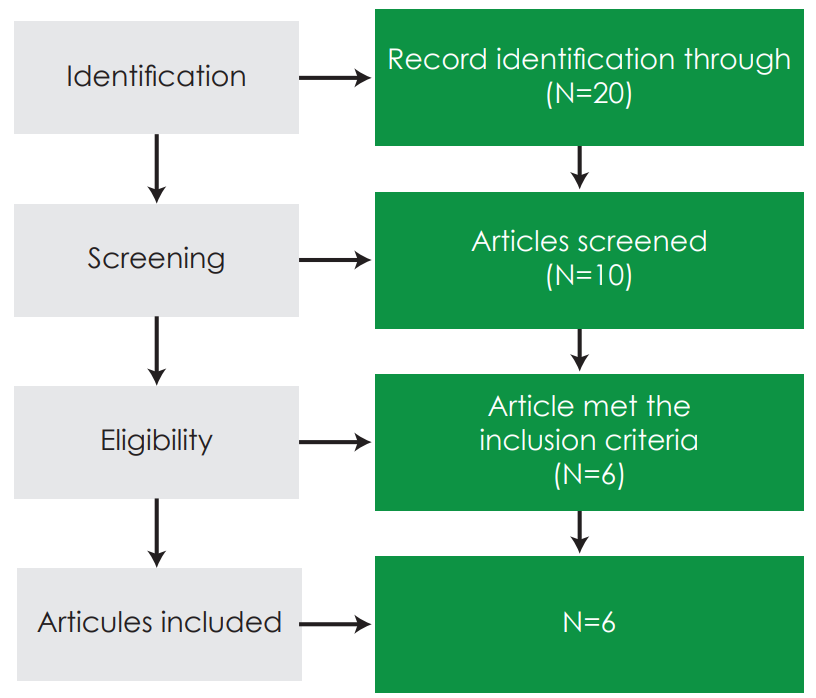
were excluded from this analysis. Details regarding characteristic features of eligible studies are repre-sented in Table-1 whereas information related to interventions and post mean and S.D. values of treatment and control group are showed in Table-2.
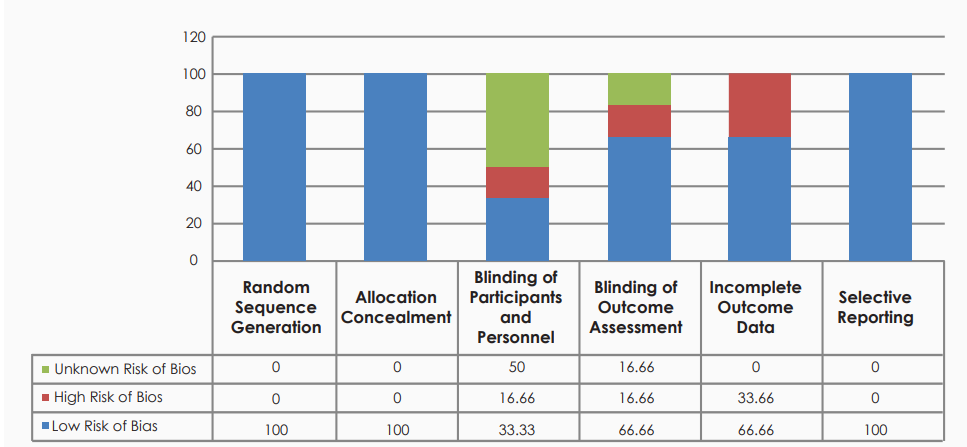
Risk of Bias
- Allocation
Random Sequence Generation
The randomization sequence was generated for entire six studies which showed low risk of bias 20-25.
Allocation Concealment
Similarly, concealed allocation was considered for all six randomized controlled trials 20-25represented low risk of bias.
2 .Blinding
Blinding of Participants and Personnel
Only two studies22,25 out of six considered the partici-pants and personnel blinding whereas three studies 20,23,24 showed unknown blinding approach while high risk of bias was revealed in one study.
Blinding of Outcome Assessment
Four20,21,23,24 out of six studies had considered the blinding of the outcome assessment. One study25 showed high risk of bias while unknown risk of bias was represented by only one study 22.
- Incomplete Outcome Data
The risk of bias configuration among four 21,22,23,25 studies showed low risk of bias while only two studies20,24 demonstrated high risk.
- Selective Reporting
The low of risk of bias was determined among all six studies20-25. Consecutively, the evaluation of risk of bias was entirely based on the author’s judgment illustrated in Table-3,
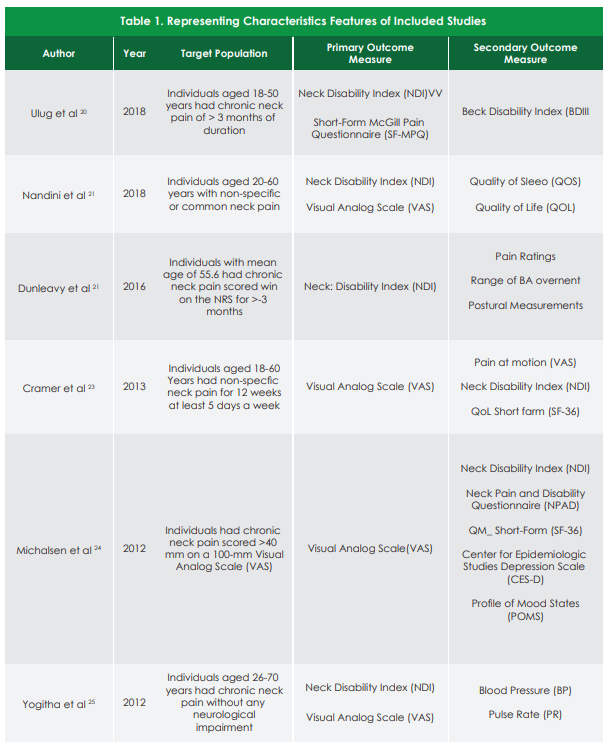
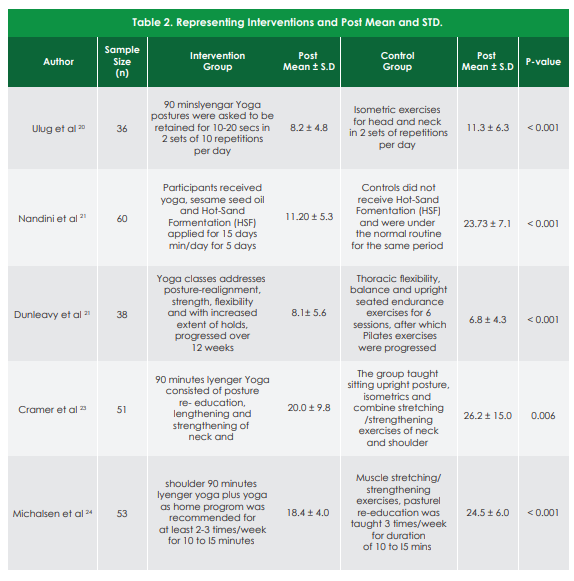
Test for Heterogeneity
Estimation of Q and I2 test were utilized to identify the statistical heterogeneity. Q=30.3279 and I2=83.51% indicated level of inconsistency within 95% of C.I (65.52 to 92.12) therefore random effect model was used for assessing the pool effects.
Synthesized Findings
The findings of six randomized controlled trials revealed results in favor of the experimental group.
The pool effects of Yoga Therapy in term of SMD as obtained in a random effect model showed an impact of -0.857 which according to a Cohen rule of thumb depicts a near to large effects of Yoga therapy in terms of reducing neck pain as shown in Table-4. Furthermore, the effect was also plotted on the forest plot to determine the pool effects in random effect model at 95% of C.I. The findings of the results of each study and its impact are illustrat-ed in Figure-3.
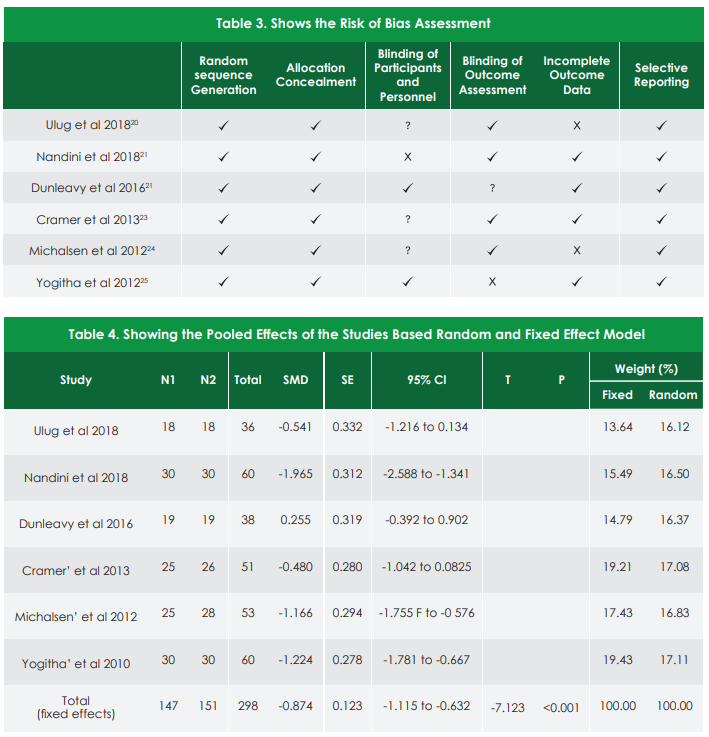
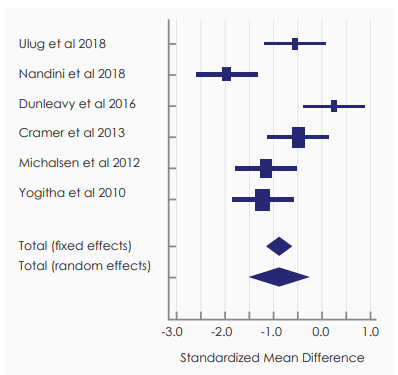
The studies included in this analysis determined the efficacy of yoga as an effective therapuetic option in relieving chronic neck pain. The robust evidence was originated from the included trials for reduction of chronic neck pain and related disability after yoga therapy based on NDI. Results of all studies have shown significant improvement in NDI after yoga intervention in cervical patients. Consider the best of author’s knowledge, it is believe that this is the first meta-analysis conducted in Pakistan analyzing six RCT’s which determined the effective-ness of yoga as a complementary therapeutic option in order to relieve chronic neck pain. Prior a systemic review and meta-analysis conducted by Cramer et al in 2017 determined the effect of yoga on chronic neck pain in comparison to usual care neck pain and disability, quality of life and mood as primary and secondary outcomes. Outcomes of the study recommended that is a better treatment option in pain management26. However, study had paucity of the selected trials which subsequently leads to a relatively small sample size; hence the validity of the study due to small sample size was an obstacle in considering the yoga as an effective tool for cervical pain patients. Another analysis was conducted in 2011 investigated efficacy of yoga therapy related to physical functioning and HRQoL (health related quality of life) in older adults includ-ing eighteen eligible studies with a sample size of 649 that concluded that yoga may be superior to conventional physical therapy intervention, howev-er; more studies were recommended to define better intersection of population, settings in which yoga will be more beneficial27. The results of this quantitative analysis indicating meaningful group differences among interventions in which yoga therapy proved to be potentially effective in reducing chronic neck pain and related disability as com-pared to isometric exercises20, hot sand fomenta-tion21, thoracic flexibility exercises22, combined exercise interventions and postural re-education23-24 and conventional physiotherapy25as reported by the trials with large sample size makes this review as an authentic and valid baseline paper that can be used for further studies. All studies included in this meta-analysis provide significant differences in the pre and post value of NDI optimizing the effective-ness of yoga intervention. Also, it has been observed that yoga was also effective as com-bined intervention based on exercise and medita-tion. Likewise, findings were consistent to a previous qualitative-analysis which established significant evidence about the effects of Iyengar yoga in relieving neck or pain28.
However, the review included only two studies that were limited to Iyengar yoga only23-24. Furthermore, no meta-analysis on other yoga styles has been conducted due to lack of researches in this area.On the contrary, the manner through which yoga enhances the physical and psychological condition aid individuals with neck pain is still not clear. As several researches have indicated the effectiveness of yoga, the physiological changes occurring in the body due to the intervention is yet to be understood. Consequently, few studies concluded the positive impact of short-term effects of yoga in reducing spinal neck or back pain whereas lack of trials leads to the limited evidence on long-term effects of yoga interventions. In addi-tion, yoga as a treatment approach may deliber-ately be considered as a secure and operative practice among patients with chronic neck pain. Consecutively, a number of clinical trials are required to be conducted to determine long term yoga effects in reducing cervical pain that will serve out to be the basis for effectiveness of yoga intervention for musculoskeletal related disorders in relieving pain among individuals.
The analysis of the included studies conducted in this paper provided robust evidence that yoga is an effective treatment approach having moderate to large pool effect of -0.857 SMD at 95% CI (p<0.0001) in decreasing chronic neck pain and related disability. Therefore it is concluded that preliminary, yoga therapy can be considered as a safe and effectual complementary method of management for individuals having chronic or non-specific neck pain.
Declaration
All authors have affirmed no potential conflicts of interests.
Funding
No aid or financial support for study and publication of this article has been received by the authors.
- Lee H, Hübscher M, Moseley GL, Kamper SJ, Traeger AC, Mansell G, McAuley JH. How does pain lead to disability? A systematic review and meta-analysis of mediation studies in people with back and neck pain. Pain. 2015;156(6):988-97
- Cohen SP. Epidemiology, diagnosis, and treatment of neck pain. InMayo Clinic Proceedings 2015 (Vol. 90, No. 2, pp. 284-299). Elsevier.
- Hoy DG, Protani M, De R, Buchbinder R. The epidemiology of neck pain. Best Pract Res ClinRheumatol. 2010;24(6):783-92.
- White RS, Jiang J, Hall CB, Katz MJ, Zimmerman ME, Sliwinski M, Lipton RB. Higher perceived stress scale scores are associated with higher pain intensity and pain interference levels in older adults.J Am Geriatr Soc. 2014;62(12):2350-6.
- Büssing A, Ostermann T, Lüdtke R, Michalsen A. Effects of yoga interventions on pain and pain-associated disability: a meta-analysis. J Pain. 2012;13(1):1-9.
- Jeitler M, Brunnhuber S, Meier L, Lüdtke R, Büssing A, Kessler C, Michalsen A. Effectiveness of Jyoti meditation for patients with chronic neck pain and psychological distress—a randomized controlled clinical trial. J Pain. 2015;16(1):77-86.
- Sharma M. Yoga as an alternative and complementary approach for arthritis: a systematic review.Evid Based Complement Alternat Med. 2014;19(1):51-8.
- Cramer H, Lauche R, Haller H, Dobos G. A systematic review and meta-analysis of yoga for low back pain.Clin J Pain. 2013;29(5):450-60.
- Posadzki P, Ernst E, Terry R, Lee MS. Is yoga effective for pain? A systematic review of randomized clinical trials. Complementary therapies in medicine. 2011;19(5):281-7.
- Uebelacker LA, Epstein-Lubow G, Gaudiano BA, Tremont G, Battle CL, Miller IW. Hatha yoga for depression: critical review of the evidence for efficacy, plausible mechanisms of action, and directions for future research. J PsychiatrPract. 2010;16(1):22-33.
- Chong CS, Tsunaka M, Chan EP. Effects of yoga on stress management in healthy adults: a systematic review. Alternative therapies in health and medicine. 2011;17(1):32.
- Hayes M, Chase S. Prescribing yoga. Primary Care: Clinics in Office Practice. 2010 ;37(1):31-47.
- Cramer H, Lauche R, Haller H, Langhorst J, Dobos G, Berger B. “I’m more in balance”: a qualitative study of yoga for patients with chronic neck pain. J Altern Complement Med. 2013;19(6):536-42.
- Cramer H, Lauche R, Hohmann C, Lüdtke R, Haller H, Michalsen A, Langhorst J, Dobos G. Randomized-controlled trial comparing yoga and home-based exercise for chronic neck pain. Clin J Pain.2013;29(3):216-23.
- Krucoff C. Healing Yoga for Neck & Shoulder Pain: Easy, Effective Practices for Releasing Tension & Relieving Pain. Oakland, CA: New Harbinger Publications, 2010.
- Clarke TC, Black LI, Stussman BJ, Barnes PM, Nahin RL. Trends in the use of complementary health approaches among adults: United States, 2002–2012. National health statistics reports. 2015(79):1.
- Van Dongen JM, Groeneweg R, Rubinstein SM, Bosmans JE, Oostendorp RA, Ostelo RW, Van Tulder MW. Cost-effectiveness of manual therapy versus physiotherapy in patients with sub-acute and chronic neck pain: a randomised controlled trial.Eur Spine J.2016;25(7):2087-96.
- Moher D, Liberati A, Tetzlaff J, Altman DG, Prisma Group. Preferred reporting items for systematic reviews and meta-analyses: the PRISMA statement. PLoS medicine. 2009;6(7):e1000097.
- Higgins JP. Cochrane handbook for systematic reviews of interventions version 5.0. 1. The Cochrane Collaboration. http://www. cochrane-handbook. org. 2008.
- UluĞ N, Yilmaz ÖT, Kara M. Effects of Pilates and Yoga in Patients with Chronic Neck Pain: a Sonographic Study. J Rehabil Med Suppl. 2018;50(1):80-5.
- Nandini B, Mooventhan A, Manjunath NK. Add-on Effect Of Hot Sand Fomentation To Yoga On Pain, Disability, And Quality Of Life In Chronic Neck Pain Patients. EXPLORE. 2018 ;14(5):373-8.
- Dunleavy K, Kava K, Goldberg A, Malek MH, Talley SA, Tutag-Lehr V, Hildreth J. Comparative effectiveness of Pilates and yoga group exercise interventions for chronic mechanical neck pain: quasi-randomised parallel controlled study. Physiotherapy. 2016 ;102(3):236-42.
- Cramer H, Lauche R, Hohmann C, Lüdtke R, Haller H, Michalsen A, Langhorst J, Dobos G. Randomized-controlled trial comparing yoga and home-based exercise for chronic neck pain. J Rehabil Med Suppl. 2013;29(3):216-23.
- Michalsen A, Traitteur H, Lüdtke R, Brunnhuber S, Meier L, Jeitler M, Büssing A, Kessler C. Yoga for chronic neck pain: a pilot randomized controlled clinical trial. J Pain. ;13(11):1122-30.
- Yogitha B, Nagarathna R, John E, Nagendra HR. Complimentary effect of yogic sound resonance relaxation technique in patients with common neck pain. International journal of yoga. 2010 Jan;3(1):18.
- Cramer H, Klose P, Brinkhaus B, Michalsen A, Dobos G. Effects of yoga on chronic neck pain: a systematic review and meta-analysis.ClinRehabil. 2017;31(11):1457-65.
- Patel NK, Newstead AH, Ferrer RL. The effects of yoga on physical functioning and health related quality of life in older adults: a systematic review and meta-analysis. J Altern Complement Med. 2012 ;18(10):902-17.
- Crow EM, Jeannot E, Trewhela A. Effectiveness of Iyengar yoga in treating spinal (back and neck) pain: a systematic review.Int J Yoga Therap. 2015;8(1):3.
